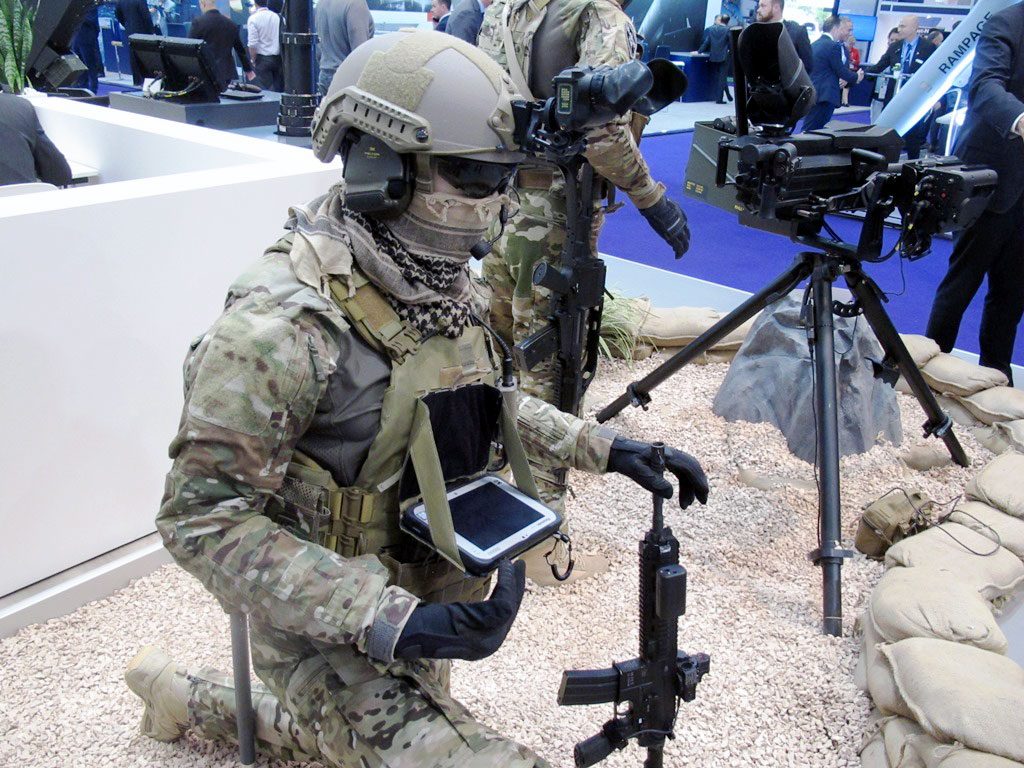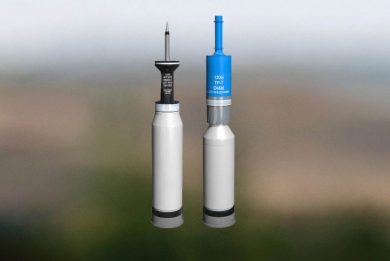Soldier systems evolution by Rheinmetall
DSEI provided the opportunity to have an insight into Rheinmetall’s soldier systems evolution and into the status of some of the contract won by the German Group.
Rheinmetall IdZ-ES (Infanterist der Zukunft – Erweitertes System, Infantryman of the Future – Extended System) has been deployed for three years in Afghanistan with German soldiers. Lessons learned during the deployment led the Bundeswehr to require a number of modification and upgrades. Based on this Rheinmetall developed a new electronic backpack which is lighter and contains an updated computer. Deliveries of this version will start in late 2019, a total of 68 platoons being equipped with this new version, which maintains full compatibility with the previously deployed system, the radios remaining the same, the SOLAR 400EG- (3) E UHF provided by Thales Germany.
Rheinmetall’s Gladius
That said for the current contracts with the Bundeswehr, Rheinmetall developed an export version known as Gladius, which 2.0 version is in the last stage of development. Building on lessons learned and thanks to miniaturisation, especially in the electronics field, the philosophy has changed the new system being more modular, which allowed developing three versions, named Light, Basic and Advanced. The Gladius 2.0 Light is dedicated to the fighter and includes a data/voice radio with GPS, the latter providing Blue Force Tracking in a fully passive way, a push-to-talk and a headset, and a USB hub in the back, allowing to add devices in a plug-and-play mode. The Basic version adds a display, in the form of a smartphone or a tablet, while the Advanced one is fitted with a shooter location system, a mini-drone and other items. No indication are given on the type of subsystems as those will be selected by the customer.

The NATO Very High Joint Readiness Task Force will include a further version of the IdZ-ES based on the Gladius 2.0
Rheinmetall is developing the so-called “System Panzergrenadier VJTF 2023” that will equip those units that will be part of the 2023 rotation of the NATO Very High Joint Readiness Task Force; this will include a further version of the IdZ-ES based on the Gladius 2.0 as well as improvements to 41 Puma infantry fighting vehicles that will be deployed by the mechanised battalion assigned to the NATO spearhead formation. Contracts with subcontractors have not yet been signed, thus no details have yet been provided, however what is clear is that a new radio will be adopted; in July 2019 Rohde & Schwarz announced that its software defined VHF/UHF radio system SOVERON was selected as vehicular and infantryman, Pumas to be equipped with the SOVERON VR vehicular radio and infantrymen with the SOVERON HR hand-held radio.
Although the system will be deployed within the German VJTF contingent, compatibility issues will have to be solved. The adoption of a gateway to ensure communication between the SOVERON and other legacy radio systems might be needed, the German Army also considering loaning its radios to friendly armed forces, i.e. to units called to augment the German contingent. Within the VJTF programme the Pumas will not only get new radios but will also see the integration of the Spike missile, known in Germany as MELLS (Mehrrollenfähiges Leichtes Lenkflugkörper-System for Multi-role lightweight guided missile system), as well as full logistic support.
A key element in any soldier system is power; since inception the German IdZ used Bren-Tronics patented batteries, the first being the full size SMP rechargeable lithium-ion battery providing 75 Wh. The first iteration of the IdZ-ES shifted to a battery of the same company, which was two-third the size and weight of the previous, providing 60 Wh, which was fully compensated as the system power consumption was reduced by 40%. The new IdZ-ES systems that will be soon delivered maintain the same battery but in an improved version, which capacity has been brought back to 75 Wh. EDR On-Line understood that the VJTF version will keep the same battery, ensuring full commonality with existing systems and allowing using the battery chargers already installed on the Pumas.
Last but not least we should not forget Rheinmetall Canada’s Argus, which is now fully in service with the Canadian Armed Forces.
Photos by Paolo Valpolini




